Pointelle knit fabric is a versatile and delicate material known for its intricate openwork pattern, adding a touch of elegance and femininity to garments.
With its lightweight and breathable nature, it has become a popular choice for creating comfortable and stylish clothing items. The fabric’s unique texture, resembling lace or eyelet, sets it apart and offers a distinct visual appeal.
You are viewing: What Is Pointelle
Pointelle knit fabric is commonly used in the fashion industry for creating dresses, tops, cardigans, and lingerie, where its delicate nature adds an element of sophistication.
While it may not provide the same level of warmth as heavier fabrics, its breathability makes it ideal for lightweight and summer clothing.
Understanding the characteristics and versatility of Pointelle knit fabric allows fashion enthusiasts and designers to explore its creative possibilities and incorporate this delicate and elegant material into their designs.
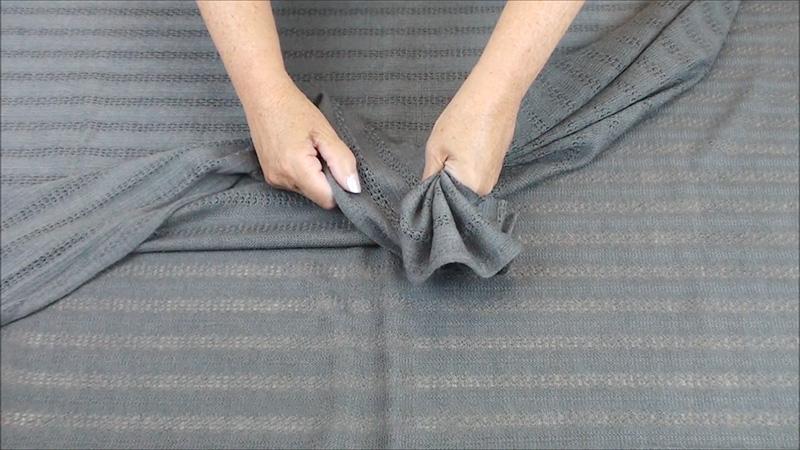
What is Pointelle Knit Fabric?
Pointelle knit fabric is a delicate and lightweight fabric characterized by its intricate openwork pattern. It is created using a knitting technique that forms small eyelet or lace-like holes in a geometric or floral design.
The fabric is often made from natural fibers like cotton or bamboo, but it can also be blended with synthetic materials for added stretch and durability.
Pointelle knit fabric is known for its feminine and textured appearance, making it popular for garments such as dresses, tops, cardigans, and lingerie. Its breathable nature and subtle texture make it especially suitable for lightweight and summer clothing.
History of Pointelle Knit Fabric
Pointelle knit fabric has a rich history that dates back to the 1950s. The term “pointelle” originated from the French word “point,” meaning stitch or needlework.
It was used to describe lace knits characterized by delicate openwork patterns and decorative “holes.”. .
In the early days, pointelle fabric was exclusively crafted using a needle, resulting in an intricate lace-like texture. The fabric gained popularity for its feminine appeal and the ability to create visually appealing patterns.
Over time, pointelle knitting techniques expanded, incorporating machines that could replicate the delicate needlework.
Today, pointelle knits continue to captivate fashion enthusiasts with their timeless elegance. This delicate and airy fabric has found its place in various garments, from lightweight sweaters and cardigans to socks, scarves, and even baby clothing, adding a touch of charm and texture to every piece.
Characteristics of Pointelle Knit Fabric
Geometric Pattern
Pointelle fabric consists of a pattern with tiny holes, usually arranged in the shape of chevrons or other geometric designs. These repeated designs create an intricate and visually appealing texture, reminiscent of lace.
Fine Knit
Pointelle fabric is crafted using fine-gauge knitting needles or machines. The stitches are closely spaced, resulting in a fabric with a fine, lightweight, and delicate nature.
Open Spaces
The defining characteristic of Pointelle knit fabric is the presence of small open spaces within the pattern. These tiny holes add breathability to the fabric, making it suitable for warm weather or layered garments.
Subtle Stripe and Floral Effects
Along with the geometric pattern, Pointelle fabric may incorporate subtle stripes or floral effects. These additional design elements enhance the aesthetic appeal and versatility of the fabric.
Lightweight and Airy
Pointelle knit fabric is known for its lightweight and airy nature. The presence of the small open spaces allows for better air circulation, making it comfortable to wear in various climates.
Delicate Nature
Due to its fine knit and intricate pattern, Pointelle fabric is inherently delicate. Care should be taken when handling and washing this fabric to preserve its beauty and integrity.
Types of Pointelle Knit Fabric
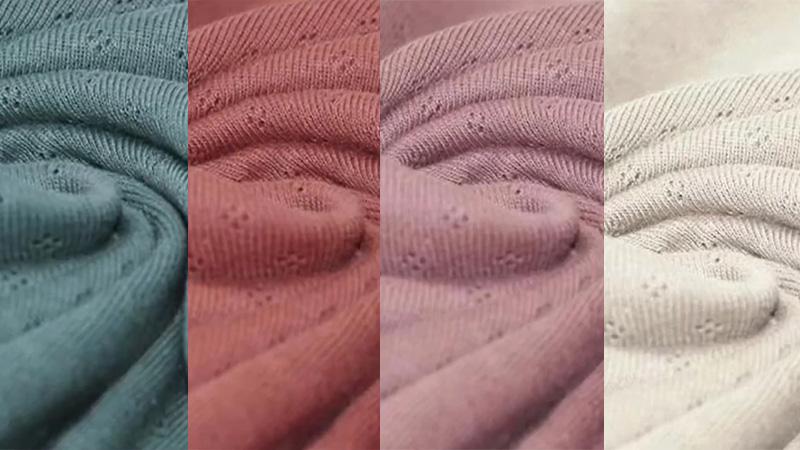
Pointelle Jersey Knit Fabric
Pointelle jersey knit fabric combines the pointelle pattern with the construction of a jersey knit. Jersey knit is known for its stretch and softness.
When combined with pointelle, it creates a fabric that is both breathable and comfortable, making it suitable for a wide range of garments like lightweight tops, dresses, and undergarments.
Pointelle Interlock Knit Fabric
Pointelle interlock knit fabric is created by interlocking two layers of fabric together, resulting in a thicker and more stable fabric. The pointelle pattern adds a delicate touch to the interlock knit, making it ideal for garments that require a bit more structure, such as fitted tops, skirts, and cardigans.
Pointelle Rib Knit Fabric
Rib knit fabric is known for its stretch and excellent recovery. Pointelle rib knit fabric combines the stretch and texture of rib knit with the delicate pointelle pattern.
This type of fabric is often used for creating fitted garments like sweaters, cuffs, and necklines, as the ribbing adds a subtle element of texture and allows the fabric to retain its shape.
What is Pointelle Knit Fabric Made of?
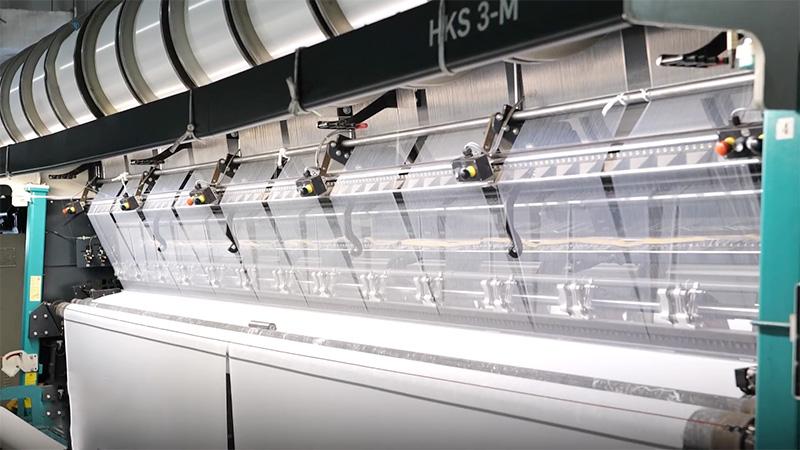
Natural Fibers
Pointelle knit fabric is commonly made from natural fibers, with cotton being the most popular choice. Cotton is highly favored for its softness, breathability, and ability to absorb moisture, making it comfortable to wear in various climates. Other natural fibers like bamboo and linen may also be used for their similar properties.
Knitting Process
The fabric is created through a knitting process, where loops of yarn are interlocked to form a continuous fabric structure. In the case of Pointelle knit fabric, the knitting process is done using specialized machines or by hand, employing specific techniques to create subtle openwork patterns and delicate textures.
Fine Gauge
Read more : What Are Pipe Cleaners
Pointelle knit fabric is produced using a fine gauge, meaning that the knitting needles or machines used have a higher number of needles per inch. This allows for the creation of smaller stitches and intricate patterns, resulting in the characteristic tiny holes and geometric designs of Pointelle.
Openwork Design
The openwork design of Pointelle knit fabric is achieved by selectively omitting stitches or incorporating intentional yarnovers, creating the desired pattern of tiny holes. These openings add visual interest, breathability, and a delicate aesthetic to the fabric.
Finishing Touches
Once the knitting process is complete, the Pointelle fabric may undergo additional finishing treatments. This can include processes like washing, dyeing, or printing to enhance the appearance, color, and texture of the fabric, as per the specific design requirements.
What is Pointelle Knit Fabric Used for?
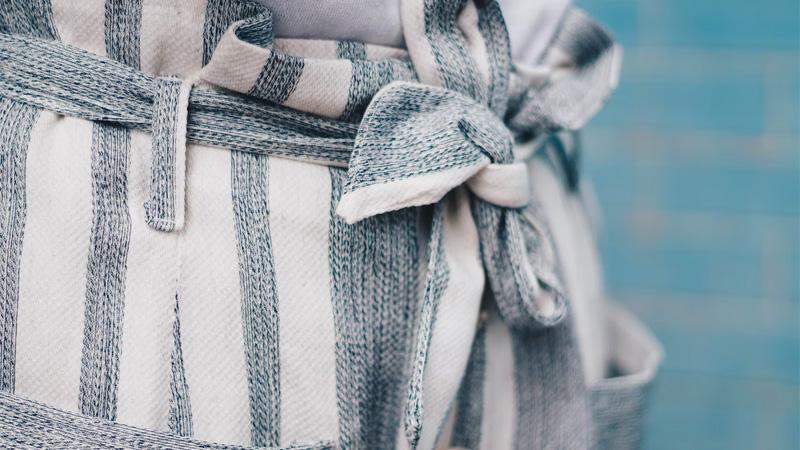
Women’s Dresses
Pointelle knit fabric is a popular choice for feminine dresses. The delicate openwork pattern and subtle texture lend an elegant and romantic touch to dresses, making them suitable for both casual and dressy occasions. Pointelle dresses can range from lightweight sundresses to more elaborate designs for special events.
Tops and T-shirts
Pointelle knit fabric is utilized in the creation of tops and t-shirts, adding a touch of visual interest and texture. The fabric’s lightweight and breathable nature makes it ideal for warm weather clothing, while the delicate patterns enhance the overall design. Pointelle tops and t-shirts can be found in various styles, from basic tees to more intricate and decorative designs.
Cardigans and Sweaters
Pointelle knit fabric is well-suited for cardigans and sweaters, as its openwork structure allows for increased breathability. These garments can range from lightweight cardigans perfect for layering to thicker sweaters with more intricate pointelle patterns, adding texture and visual appeal.
Kids’ Wear
Pointelle knit fabric is also used in the manufacturing of kids’ clothing. Its delicate and charming appearance makes it suitable for creating adorable outfits for both girls and boys. Pointelle dresses, rompers, tops, and even socks for children are commonly made from this fabric.
Lingerie and Sleepwear
Pointelle knit fabric’s softness and delicate texture make it a popular choice for lingerie and sleepwear. It is used in the creation of panties, bras, camisoles, pajamas, nightgowns, and loungewear. The fabric’s breathable nature ensures comfort during sleep, while the pointelle pattern adds a touch of femininity.
Bags and Accessories
Pointelle knit fabric is not limited to clothing alone. It is also employed in the creation of bags, such as tote bags or small purses, adding a unique and stylish element. Additionally, it can be used for accessories like scarves, headbands, and even hats, showcasing the fabric’s versatility.
Is Pointelle Fabric Warm?
Pointelle fabric is not known for its warmth compared to other fabrics like wool or fleece. As a lightweight and breathable knit fabric, it is best suited for summer clothing rather than winter wear.
The openwork pattern and the small holes in pointelle fabric allow for better air circulation, which may not provide sufficient insulation in colder temperatures.
While pointelle fabric can add texture and visual interest to garments, it does not possess the same level of thermal insulation as heavier or denser fabrics.
Therefore, if warmth is a priority, it is advisable to opt for fabrics that are specifically designed for winter clothing to ensure proper insulation and comfort in colder weather.
Is Another Name for Pointelle Fabric?
Another name for pointelle fabric is “openwork knit fabric.” The term “openwork” refers to the characteristic pattern of small holes or openings in the fabric.
It describes the intricate and delicate nature of the knit, highlighting the unique texture and design. This alternative name emphasizes the fabric’s structure rather than a specific brand or style, making it a more general term to describe knit fabrics with openwork patterns.
So, if you come across the term “openwork knit fabric,” it can be used interchangeably with pointelle fabric to refer to the same type of fabric with its distinctive appearance and characteristics.
How Do You Wash Pointelle Knit Fabric?
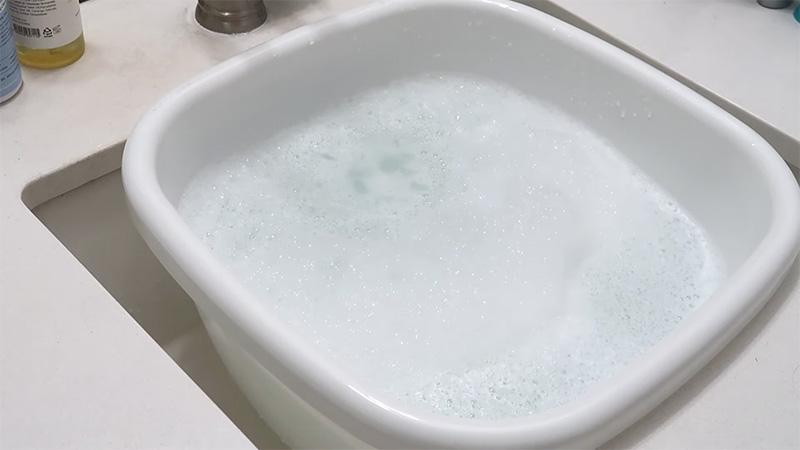
Check the Care Label
Before washing, always refer to the care label on the garment for specific instructions and any recommended temperature settings.
Use Mild Detergent
Choose a mild detergent specifically formulated for delicate fabrics. Avoid using harsh chemicals or bleach, as they can damage the fabric.
Cold Rinse
Start by rinsing the Pointelle knit fabric in cold water. This helps remove any surface dirt or residue.
Hand Wash or Gentle Machine Wash
Hand washing is typically the gentlest method for Pointelle knit fabric. Fill a clean basin or sink with cold or lukewarm water and add a small amount of mild detergent.
Gently agitate the fabric in soapy water, being careful not to stretch or wring it. Rinse thoroughly.
Alternatively, if the care label permits, you can opt for a warm gentle machine wash using the delicate or wool cycle. Place the garment in a mesh laundry bag to protect it from friction and potential damage during the wash cycle.
Do Not Soak
Avoid soaking Pointelle knit fabric for an extended period, as this can lead to stretching or distortion of the delicate stitches.
Handle With Care
When washing or rinsing, avoid excessive wringing, twisting, or rubbing, as these actions can cause the fabric to lose its shape or stretch.
Dry Flat
After washing, gently squeeze out excess water without wringing. Lay the garment flat on a clean towel or drying rack to air dry. Avoid hanging Pointelle knit fabric, as it may stretch under its weight.
How to Care for Pointelle Knit Clothes?
Read the Care Instructions
Before washing or caring for your Pointelle knit clothes, carefully read and follow the care instructions on the garment’s label. These instructions may include specific temperature settings and additional guidelines for that particular item.
Hand Wash or Use a Gentle Cycle
Read more : What Is An Lic
Pointelle knit clothes are best washed by hand or using a gentle cycle on your washing machine. If hand washing, use cool water and a mild detergent specifically designed for delicate fabrics.
Avoid Soaking
Avoid soaking Pointelle knit clothes for an extended period as it may lead to stretching or distortion of the delicate fabric. Instead, gently agitate the clothes in soapy water and rinse thoroughly.
Skip the Dryer
Pointelle knit clothes should not be tumble dried as heat and agitation can damage the fabric. Instead, gently squeeze out excess water and lay them flat on a clean towel or drying rack to air dry.
Reshape the garments while damp to retain their original shape.
Avoid Ironing
Pointelle knit clothes do not typically require ironing. The delicate fabric may be easily damaged by heat. If necessary, you can use a cool iron setting or steam iron at the lowest temperature to remove any wrinkles, but it’s best to test on a small, inconspicuous area first.
Store Carefully
When not in use, store your Pointelle knit clothes folded rather than hanging to prevent stretching or distortion. Keep them in a cool, dry place away from direct sunlight or heat sources.
How to Sew Pointelle Knit Fabric?
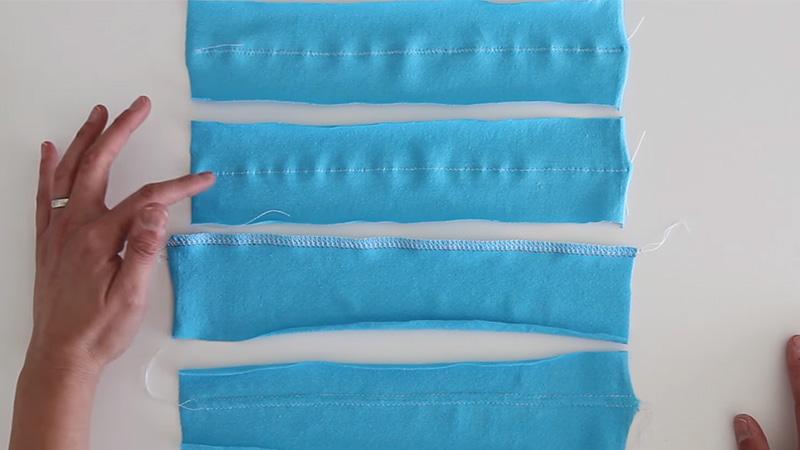
Use the Right Needles
Select a sewing machine needle suitable for knit fabrics, such as a ballpoint or stretch needle. These needles have rounded tips that slide between the yarns of the fabric, minimizing the risk of snagging or damaging the delicate knit.
Choose the Correct Thread
Opt for a high-quality polyester or cotton thread that matches the color of the fabric. These threads have some stretch and will help maintain the integrity of the seam when the fabric stretches.
Adjust the Stitch
Use a stretch stitch on your sewing machine, such as a narrow zigzag or a stretch stitch designed for knits. This type of stitch allows the seam to stretch with the fabric, preventing it from breaking or popping under tension.
Test the Stitch
Before sewing your actual project, test the stitch and tension on a scrap piece of Pointelle knit fabric to ensure the machine settings are appropriate. Adjust the tension if needed to avoid the fabric from puckering or stretching.
Use Pins or Clips
When pinning or securing the fabric pieces together, be gentle to avoid stretching or distorting the knit. Use fine pins or clips specifically designed for knits to minimize any damage to the fabric.
Seam Finishing
Consider using a serger/overlocker to finish the seams or use a small zigzag stitch along the seam allowances to prevent fraying. You can also use a narrow twin needle for a decorative finish on hems and edges.
Press With Caution
Pointelle knit fabric is delicate and can easily lose its shape under high heat. If pressing is necessary, use a low heat setting or place a pressing cloth between the fabric and the iron to avoid direct contact. Alternatively, you can opt for steam pressing or finger pressing to shape the fabric as needed.
Take Your Time
Sewing Pointelle knit fabric requires patience and care. Take your time to ensure smooth and even stitches without stretching or distorting the fabric.
How Does Pointelle Knit Fabric Impact the Environment?
Material Sourcing
Pointelle knit fabric can be made from various materials, including natural fibers like cotton, bamboo, or linen. When these fibers are sourced sustainably and produced using organic farming practices, they have a lower impact on the environment compared to synthetic fibers. Organic farming avoids the use of harmful pesticides and promotes soil health and biodiversity.
Water and Energy Consumption
The manufacturing process of Pointelle knit fabric, including spinning, knitting, and dyeing, requires water and energy. Depending on the production methods used, these processes can have varying levels of environmental impact.
Eco-friendly manufacturing practices that aim to reduce water and energy consumption, as well as minimize chemical usage, can help mitigate the environmental footprint of Pointelle knit fabric.
Chemical Use
The dyeing and finishing processes of Pointelle knit fabric may involve the use of chemicals, such as dyes, bleaches, and softeners. Traditional chemical dyes can have negative impacts on water pollution and human health.
However, there are eco-friendly dyeing methods, such as natural or low-impact dyes, that minimize the use of harmful chemicals and reduce environmental harm.
Durability and Longevity
The durability and longevity of Pointelle knit fabric play a role in its environmental impact. High-quality, well-made garments can last longer and reduce the need for frequent replacements, thereby reducing overall resource consumption and waste generation.
Disposal and Decomposition
Like most textiles, when Pointelle knit fabric reaches the end of its life cycle, its disposal can impact the environment. Synthetic fibers, if used in the fabric, may take a long time to decompose in landfills. However, natural fibers like cotton and bamboo are biodegradable and have a lower environmental impact.
What Are the Advantages and Disadvantages of Pointelle Knit Fabric?
Advantages
- Delicate and Feminine: Pointelle knit fabric is known for its delicate and feminine appearance. The openwork pattern creates a visually appealing texture, adding a touch of elegance and charm to garments.
- Breathable and Lightweight: Pointelle knit fabric is typically lightweight and airy, allowing for good airflow. This makes it a suitable choice for warm-weather clothing, as it helps keep the body cool and comfortable.
- Textured and Unique Design: The intricate pointelle pattern of the fabric gives it a unique and textured look. This adds visual interest to garments, making them stand out and adding depth to their overall design.
- Versatile Applications: Pointelle knit fabric can be used for a variety of clothing items, including dresses, tops, cardigans, and lingerie. Its versatility allows for creativity and a wide range of design possibilities.
Disadvantages
- Fragile and Prone to Snagging: Due to its openwork structure, Pointelle knit fabric is more delicate and susceptible to snagging compared to solid knits. Care must be taken while handling and wearing garments made from this fabric to avoid catching on sharp objects.
- Limited Warmth: Pointelle knit fabric is not as warm as heavier fabrics like wool or fleece. It is best suited for lightweight and summer clothing rather than providing insulation in colder temperatures.
- Care Requirements: Pointelle knit fabric requires special care to maintain its delicate nature. It may need to be washed by hand or using a gentle cycle, and it should be air-dried flat to avoid stretching or distorting the fabric.
- Transparency: Depending on the density of the pointelle pattern and the fabric’s color, Pointelle knit fabric can be somewhat transparent. This may require layering or wearing suitable undergarments to maintain modesty.
Comparison Table Between Pointelle Knit Fabric and Other Fabrics
FAQs
To Recap
Pointelle knit fabric is a delicate and lightweight fabric known for its intricate openwork pattern. It offers a feminine and textured look, making it a popular choice for garments such as dresses, tops, cardigans, and lingerie.
The fabric is breathable, allowing for good airflow and making it suitable for lightweight and summer clothing. However, it is not as warm as heavier fabrics, like wool or fleece, and may require layering for colder weather.
Pointelle knit fabric requires special care to maintain its delicate nature, including gentle washing, avoiding high heat, and air-drying flat. While it may not be as durable or suitable for high-impact activities, it offers a unique and elegant aesthetic.
By understanding its characteristics and properly caring for it, Pointelle knit fabric can enhance your wardrobe with its delicate texture and versatile applications.
Source: https://t-tees.com
Category: WHAT
